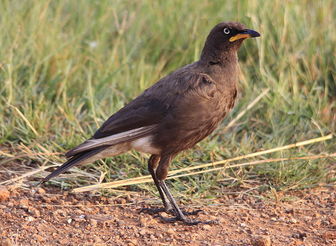African Pied Starling
The adult of this 27–28 cm long starling has mainly dully glossed black plumage except for a white lower belly and undertail. It has a white iris and yellow lower mandible. The sexes are alike, but the juvenile has unglossed plumage, a brown iris and a dull yellow lower mandible. There are no subspecies. This species has a number of calls, but the most familiar is a skeer kerrra kerrra. There is also a soft warbling song.

Original source: Derek Keats from Johannesburg, South Africa
Author: Derek Keats from Johannesburg, South Africa
The African Pied Starling is classified as Least Concern. Does not qualify for a more at risk category. Widespread and abundant taxa are included in this category.
Juvenile African Pied Starlings (Spreo bicolor) have a dark brown iris, but after the first year iris color changes progressively until adult birds have a creamy-white iris. Using light and electron microscopy, we found that the pigment epithelium of the iris remains pigmented, while changes occur in the pigmentation of the anterior border layer and the stroma of the subadult and adult iris. More
The African Pied Starling, Spreo bicolor, is a bird endemic to South Africa, Lesotho and Swaziland. It is common in most of its range, but largely absent from the arid northwest and the eastern lowlands of South Africa. It is found in open habitats such as grassland, karoo scrub, thornbush and agricultural land, and often associates with farm animals. More
African Pied Starling (Lamprotornis bicolor) = French: Spréo bicolore German: Spanish: Estornino Bicolor Other common names: Pied Starling Taxonomy: Turdus bicolor J. F. Gmelin, 1789, Cape of Good Hope, South Africa. Until recently was usually placed in genus Spreo. Monotypic. Distribution: South Africa (except NW, N & E), Lesotho and W Swaziland. More
African Pied Starling (Lamprotornis bicolor) * Least Concern Get the latest Flash Player to see this video. More material of this species * 3Perched on a f...South Africa, Nov 2008 Fran Trabalon * 2.5Bird sat on a ... More
African Pied Starlings are gregarious birds; they feed in flocks and large numbers congregate at roosts in reedbeds and copses (up 1550 counted at roosts). Diet These birds forage on the ground, mainly for invertebrates, but also eats seeds, nectar and fruit. They follow livestock, feeding on disturbed insects, and on ticks on sheep and cattle. May form mixed-species foraging flocks with Wattled Starlings. Allofeeding has often been observed; this may contribute to bonding between individuals. More
The African Pied Starling is mainly blackish brown, with a slight sheen or glossy look - greenish on the tail. The undertail and lower belly is white. This is a large, long-legged starling, which runs confidently along the ground. The African Pied Starling is a common species of the interior highveld, karoo and farmlands of the eastern and western Cape . It is a gregarious bird, usually seen in loose flocks in open veldt. More
Rezultati za: african pied starlingPrijevodi 1 - 30 of 215 Engleski Engleski Finski Finski african pied starling kapinkottarainen, Spreo bicolor african pied hornbill kirjotoko, Tockus fasciatus african pied wagtail afrikanvästäräkki, Motacilla aguimp asian pied starling kyläkottarainen, Sturnus contra pied laikullinen little pied cormorant australianmerimetso, Phalacrocorax melanoleucos pied wheatear More
The African Pied Starling usually nests in tunnels in river banks, but will use holes in buildings, straw bales or natural tree holes. There is a record (Brooke 1995) of a nest being constructed in a wrecked ship 200 m from the shore. The nest is lined with a wide variety of plant material and items of human waste such as paper and rope. The 2–6, usually four, eggs are blue-green, immaculate or with some red spots. More
The African Pied Starling is gregarious and when not breeding will form large flocks, sometimes numbering more than 1000 birds. Its roosts may be shared by Lesser Kestrels or Wattled Starlings. It will feed with European Starlings, but they rarely roost together. Food Like other starlings this bird is an omnivore taking a wide range of invertebrates such as butterflies, bees, wasps, locusts and ants, but also seeds and berries. More

